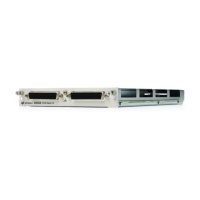20 Keysight 34950A User’s Guide
For example, the following SCPI commands set a 34950A in slot 5 to have a 16-bit
input using synchronous handshake. Two data inputs are then performed and the
strobe line is pulsed for each query. The I/O direction line is set high following the
first SENSe:DIGital:DATA:WORD? query and remains high until the digital
channel is reset or reconfigured.
CONF:DIG:WIDT WORD, (@5101)
CONF:DIG:DIR INP, (@5101)
CONF:DIG:HAND SYNC, (@5101)
SENS:DIG:DATA:WORD? (@5101)
SENS:DIG:DATA:WORD? (@5101)
Synchronous Unbuffered Outputs
For synchronous handshake unbuffered outputs, the H0 line indicates the
direction of the transfer. This line is set low to indicate an output operation. The
H0 line will remain in the low state until the 34950A direction is changed. The H1
line is the strobe output line.
When the 34950A executes an output command, it sets the data lines and waits
for T
CYCLE
/2 before asserting the strobe line. The leading edge of the strobe
indicates the data is valid. The strobe line is asserted for T
CYCLE
/2 and then
de-asserted. The H2 line is not used and is set to high impedance.
The timing of the output operation is controlled by the T
CYCLE
parameter set using
the CONFigure:DIGital:HANDshake:RATE command. This setting affects
strobe width, memory clock rate, as well as the setup and hold times. Alternatively,
the reciprocal form of the command CONFigure:DIGital:HANDshake:CTIMe
can be used to specify the speed in terms of time instead of a rate. The timing
should be set such that the device receiving the data can read the data lines
during the T
CYCLE
/2 time.
A synchronous unbuffered output is shown in the diagram below (default
handshake line polarity)

